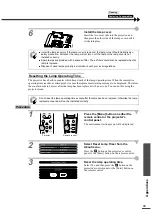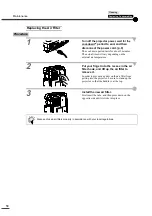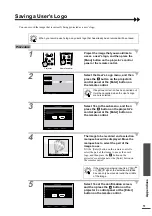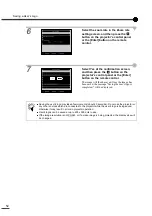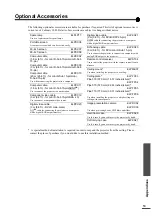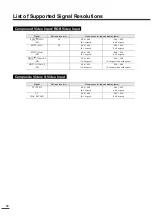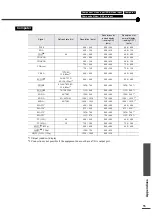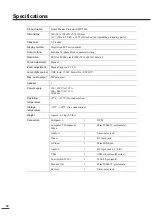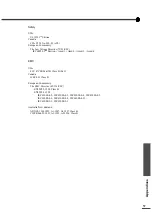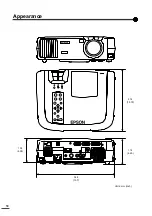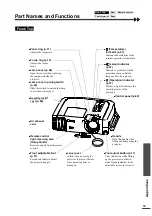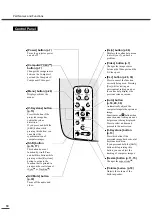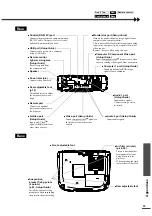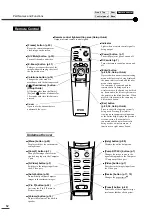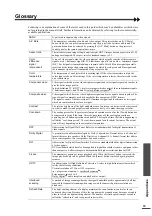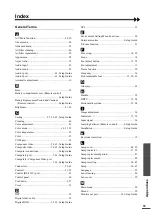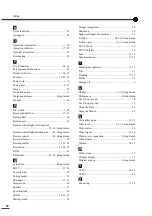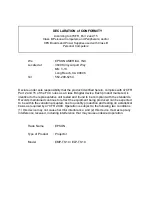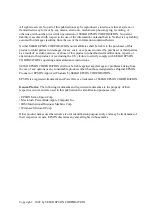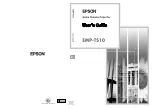
63
Appendices
Glossary
Following is an explanation of some of the terms used in this guide which may be unfamiliar or which were
not explained in the manual itself. Further information can be obtained by referring to other commercially-
available publications.
5BNC
A port used to input analog video signals.
A/V Mute
The momentary canceling of audio and video output. This projector has an [A/V Mute]
button which you can press to momentarily stop the projection of pictures and sound. The
picture and sound can be restored by pressing the [A/V Mute] button on the projector’s
control panel or the remote control once more.
Aspect ratio
The ratio between an image's length and its height. HDTV images have an aspect ratio of 16:9
and appear elongated. The aspect ratio for standard images is 4:3.
Color
difference
signal
(component)
A type of video signal output by video equipment which actually consists of three separate
signals: a red + luminance signal (R-Y), a luminance signal (Y) and a blue + luminance signal
(B-Y). Each signal is transmitted along a separate cable. Color difference signals generally
result in a better image than composite signals (in which the red, green and blue signals and
the luminance signal are all transmitted along a single cable).
Color
temperature
The temperature of an object which is emitting light. If the color temperature is high, the
colors tend to take on a bluish tinge. If the color temperature is lower, the colors tend to take
on a reddish tinge.
Component video
Video signals which have the video brightness signals and color signals separated, in order to
provide better image quality.
In high-definition TV (HDTV), it refers to images which consist of three independent signals:
Y (luminance signal), and Pb and Pr (color difference signals
).
Composite video
Video signals which have the video brightness signals and color signals mixed together. The
type of signals commonly used by household video equipment (NTSC format).
The signals consist of the carrier signal Y (luminance signal) and the chroma (color) signal
which are contained in the color bar signal.
Contrast
The relative brightness of the light and dark areas of an image can be increased or decreased
in order to make text and graphics stand out more clearly, or to make them appear softer.
Cool-down
The cooling process for the projector's lamp unit continues even after the [Power] button has
been pressed to turn off the lamp. After the lamp turns off, the cooling fan continues
operating, but all button operations are disabled. The length of time that this is happening is
called the "cool-down period". The cool-down period lasts for about 2 minutes. The actual
time will vary depending on the external air temperature.
DFP
Abbreviation for Digital Flat Panel. Refers to a standard method for digital transmission of
video signals.
Dolby Digital
A proprietary sound format developed by Dolby Laboratories. Normal stereo is a 2-channel
format that uses two speakers. Dolby Digital is a 6-channel (5.1 channel) format that adds to
this a center speaker, two rear speakers and a sub-woofer.
DVI
Abbreviation for Digital Visual Interface. Refers to a standard method for digital transmission
of video signals.
DVI is a standard which has also been applied to digital household electronic equipment other
than computers. It allows images to be transmitted at higher resolutions than for DFP.
Freeze
The momentary pausing of image playback only. When the [Freeze] button is pressed, the
image playback only can be paused. When the [Freeze] button is pressed again, playback
resumes.
HDTV
An abbreviation for High-Definition Television. It refers to high-definition systems which
satisfy the following conditions.
Vertical resolution of 750p or 1125i or greater
(p = progressive scanning, i = interlaced scanning
)
Screen aspect ratio of 16:9
Dolby Digital
audio reception and playback (or output)
Interlaced
scanning
A method of image scanning whereby the signal bandwidth used is approximately half that
required for sequential scanning when images with the same still picture resolution are
broadcast.
Refresh Rate
The light-emitting element of a display maintains the same luminosity and color for an
extremely short time. Because of this, the image must be scanned many times per second in
order to refresh the light emitting element. The number of refresh operations per second is
called the "refresh rate", and is expressed in hertz (Hz).
Содержание EMP-TS10
Страница 1: ...Printed in Japan 402171700 9002556 02 01 A C05 Printed on 100 recycled paper E ...
Страница 5: ...3 ...
Страница 6: ......
Страница 36: ......
Страница 60: ...58 Appearance 274 10 79 114 4 49 348 13 7 104 4 09 Units mm inch ...
Страница 72: ...Printed in Japan 402171700 9002556 02 01 A C05 Printed on 100 recycled paper E ...

